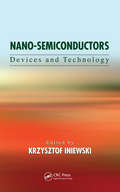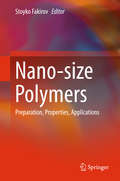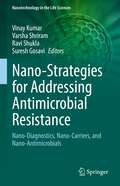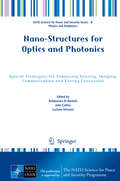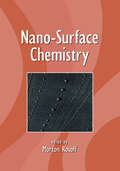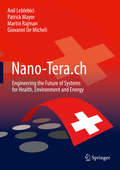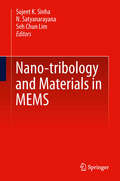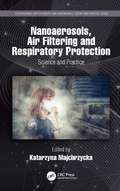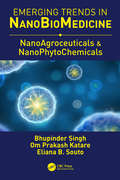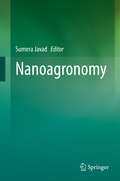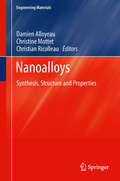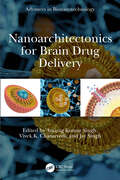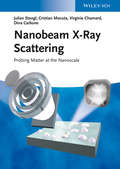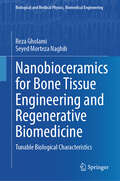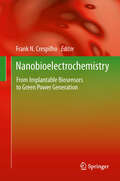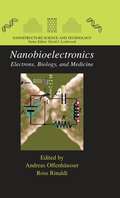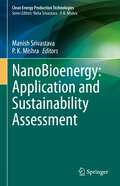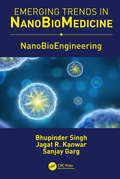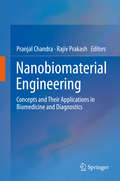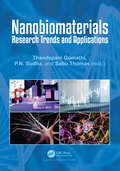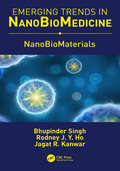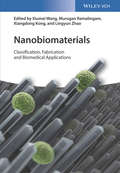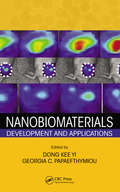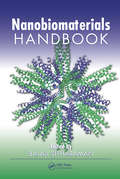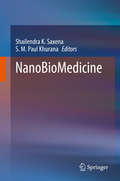- Table View
- List View
Nano-Semiconductors: Devices and Technology (Devices, Circuits, and Systems)
by Krzysztof IniewskiWith contributions from top international experts from both industry and academia, Nano-Semiconductors: Devices and Technology is a must-read for anyone with a serious interest in future nanofabrication technologies. Taking into account the semiconductor industry’s transition from standard CMOS silicon to novel device structures—including carbon nanotubes (CNT), graphene, quantum dots, and III-V materials—this book addresses the state of the art in nano devices for electronics. It provides an all-encompassing, one-stop resource on the materials and device structures involved in the evolution from micro- to nanoelectronics. The book is divided into three parts that address: Semiconductor materials (i.e., carbon nanotubes, memristors, and spin organic devices) Silicon devices and technology (i.e., BiCMOS, SOI, various 3D integration and RAM technologies, and solar cells) Compound semiconductor devices and technology This reference explores the groundbreaking opportunities in emerging materials that will take system performance beyond the capabilities of traditional CMOS-based microelectronics. Contributors cover topics ranging from electrical propagation on CNT to GaN HEMTs technology and applications. Approaching the trillion-dollar nanotech industry from the perspective of real market needs and the repercussions of technological barriers, this resource provides vital information about elemental device architecture alternatives that will lead to massive strides in future development.
Nano-size Polymers
by Stoyko FakirovThis book details all current techniques for converting bulk polymers into nano-size materials. The authors highlight various physical and chemical approaches for preparation of nano-size polymers. They describe the properties of these materials and their extensive potential commercial applications.
Nano-Strategies for Addressing Antimicrobial Resistance: Nano-Diagnostics, Nano-Carriers, and Nano-Antimicrobials (Nanotechnology in the Life Sciences)
by Vinay Kumar Varsha Shriram Ravi Shukla Suresh GosaviAntibiotics, the backbone of modern clinical-medicine, are facing serious challenges from emerging antimicrobial-resistance (AMR), a complicated phenomenon expanding in bacterial species, from nosocomial to community origins, where microbes are no longer sensitive to a range of commonly used antibiotics. AMR has exploded in recent years and is posing a serious threat to human health and survival. This necessitates novel and effective ways of diagnosis, drug-delivery, and treatment; nanotechnology and advanced nanomaterials are hailed as a potent solution in containing AMR.The main thrust of this volume is to explain the most current research on the central theme of potential use of nano-approaches for diagnosis, detection, drug-delivery and as antimicrobial agents against drug-resistant pathogenic microbes. This book provides an integrated blend of basic and advanced information for students, scholars, scientists and practitioners, interested or already engaged in research in these areas. We have brought together leading international authors to present and highlight various aspects of nanotechnology in combating AMR in WHO-prioritized microbes. Topics range from advances in nanomaterial synthesis, characterization, functionalization and improvisation, as well as applications in sensing, diagnosis of AMR, and their therapeutic and drug-delivery potential against MDR and XDR microbial phenotypes.
Nano-Structures for Optics and Photonics
by Baldassare Di Bartolo John Collins Luciano SilvestriThe contributions in this volume were presented at a NATO Advanced Study Institute held in Erice, Italy, 4-19 July 2013. Many aspects of important research into nanophotonics, plasmonics, semiconductor materials and devices, instrumentation for bio sensing to name just a few, are covered in depth in this volume The growing connection between optics and electronics, due to the increasing important role plaid by semiconductor materials and devices, find their expression in the term photonics, which also reflects the importance of the photon aspect of light in the description of the performance of several optical systems. Nano-structures have unique capabilities that allow the enhanced performance of processes of interest in optical and photonic devices. In particular these structures permit the nanoscale manipulation of photons, electrons and atoms; they represent a very hot topic of research and are relevant to many devices and applications. The various subjects bridge over the disciplines of physics, biology and chemistry, making this volume of interest to people working in these fields. The emphasis is on the principles behind each technique and on examining the full potential of each technique.
Nano-Surface Chemistry
by Morton RosoffContaining more than 2600 references and over 550 equations, drawings, tables, photographs, and micrographs, This book describes hierarchical assemblies in biology and biological processes that occur at the nanoscale across membranes and at interfaces. It covers recurrent themes in nanocolloid science, including self-assembly, construction of supra
Nano-Tera.ch: Engineering the Future of Systems for Health, Environment and Energy
by Anil Leblebici Patrick Mayor Martin Rajman Giovanni De MicheliThis book presents the overall vision and research outcomes of Nano-Tera.ch, which is a landmark Swiss federal program to advance engineering system and device technologies with applications to Health and the Environment, including smart Energy generation and consumption. The authors discuss this unprecedented nation-wide program, with a lifetime of almost 10 years and a public funding of more than 120 MCHF, which helped to position Switzerland at the forefront of the research on multi-scale engineering of complex systems and networks, and strongly impacted the Swiss landscape in Engineering Sciences.
Nano-tribology and Materials in MEMS
by N. Satyanarayana Seh Chun Lim Sujeet K. SinhaThis book brings together recent developments in the areas of MEMS tribology, novel lubricants and coatings for nanotechnological applications, biomimetics in tribology and fundamentals of micro/nano-tribology. Tribology plays important roles in the functioning and durability of machines at small length scales because of the problems associated with strong surface adhesion, friction, wear etc. Recently, a number of studies have been conducted to understand tribological phenomena at nano/micro scales and many new tribological solutions for MEMS have been proposed.
Nanoaerosols, Air Filtering and Respiratory Protection: Science and Practice (Occupational Safety, Health, and Ergonomics)
by Katarzyna MajchrzyckaRecent toxicological studies show that nanoparticles released in technological processes and combustion processes outside industry can be dangerous for humans especially when entering the body through the mouth and nose. In connection with the above, the use of adequately effective respiratory protection equipment is of great importance in prophylactic and preventive activities. The first part of Nanoaerosols, Air Filtering and Respiratory Protection: Science and Practice refers to the general phenomena of filtration described on the basis of the authors’ own experience and international reports. The book also includes a description of the respiratory system and principles of its functioning and the accumulation of aerosol particles. It goes on to discuss technological innovations regarding the production of filtering materials for protection against nanoparticles and the latest test methods. Finally, the book contains information about the proper selection and use of respiratory protective devices against airborne nanoparticles in the workplace and everyday life. Special attention is paid to proper fit procedures as well as use and maintenance activities of such devices. The content of the book with rich illustrative material has been presented so that it can be used by health and safety experts, students as well as employers, employees and private users of respiratory protective devices. "Through a comprehensive approach to the subject of the work, the authors present theoretical foundations as well as practical solutions that are used in the research and development of personal respiratory protection. The complementarity of the information contained in the book will allow the reader to become familiar with a wide range of knowledge related to the design and manufacture as well as assessment of properties and procedures for the use of respiratory protection against the adverse effects of aerosols, including air contaminated with nanoparticles and microparticles. In my opinion the book is a valuable part of the series Occupational Safety, Health, and Ergonomics: Theory and Practice, published by Taylor & Francis." —Maciej Boguń, ŁUKASIEWICZ – The Textile Research Institute, Łódź
NanoAgroceuticals & NanoPhytoChemicals
by Bhupinder SinghThis book volume encompasses the recent trends made in the applications of nanoscale tools for diverse constituents of plants and agriculture, particularly in addressing the critical issues related to their safety, efficacy, and efficient and cost-efficient development and production.
Nanoagronomy
by Sumera JavadIn this age of population explosion and depleting natural resources, this book offers new techniques to produce more from agricultural crops at a lower cost. The field of agronomy addresses this issue and interacts with the fields of agriculture, botany, and economics. Nanotechnology and nanoparticles play a role in agronomy. This book will join the techniques from both fields to construct one comprehensive book. Students of agriculture, physics, nanotechnology, and plant sciences will benefit equally from this work.
Nanoalloys
by Christine Mottet Christian Ricolleau Damien AlloyeauBimetallic nanoparticles, also called nanoalloys, are at the heart of nanoscience because of their ability to tune together composition and size for specific purposes. By approaching both their physical and chemical properties, Nanoalloys: Synthesis, Structure & Properties provides a comprehensive reference to this research field in nanoscience by addressing the subject from both experimental and theoretical points of view, providing chapters across three main topics: Growth and structural properties Thermodynamics and electronic structure of nanoalloys Magnetic, optic and catalytic properties The growth and elaboration processes which are the necessary and crucial part of any experimental approach are detailed in the first chapter. Three chapters are focused on the widely used characterization techniques sensitive to both the structural arrangements and chemistry of nanoalloys. The electronic structure of nanoalloys is described as a guide of useful concepts and theoretical tools. Chapters covering thermodynamics begin with bulk alloys, going to nanoalloys via surfaces in order to describe chemical order/disorder, segregation and phase transitions in reduced dimension. Finally, the optical, magnetic and catalytic properties are discussed by focusing on nanoparticles formed with one element to track the modifications which occur when forming nanoalloys. The range and detail of Nanoalloys: Synthesis, Structure & Properties makes it an ideal resource for postgraduates and researchers working in the field of nanoscience looking to expand and support their knowledge of nanoalloys.
Nanoarchitectonics for Brain Drug Delivery (Advances in Bionanotechnology)
by Anurag Kumar Singh Vivek K. Chaturvedi Jay SinghThis book discusses basics of brain diseases and the role of nanobiotechnology in existing treatment options for neurodegenerative disorders. It begins with an overview of brain diseases and the need for novel drug-delivery approaches. It highlights the current route for the intranasal advanced drug-delivery systems for brain diseases. It also discusses innovative categories of drug-delivery systems, including mesoporous silica nanoparticles, polymeric nanocarriers, and lipid-based nanocarriers through multi-responsive DDSs and their implications in brain disorders.Features: Includes an overview of brain diseases and highlights the need for novel drug-delivery approaches Focuses on theoretical aspects of advanced drug-delivery systems for brain diseases including challenges and progress in nose-to-brain delivery Provides an overview of technological approaches and their implications for neurodegenerative disorders, central nervous system (CNS), and brain drug delivery in brain cancer Discusses key advances in the development of polymer nanoparticles for drug delivery to the CNS Reviews the role of herbal medicines and naturally derived polymeric nanoparticle for the treatment of neurodegenerative disorders This book is aimed at graduate students and researchers in biomedical engineering, biotechnology, drug delivery, and neurology.
Nanobeam X-Ray Scattering: Probing Matter at the Nanoscale
by Dina Carbone Julian Stangl Virginie Chamard Cristian MocutaA comprehensive overview of the possibilities and potential of X-ray scattering using nanofocused beams for probing matter at the nanoscale, including guidance on the design of nanobeam experiments. <P><P>The monograph discusses various sources, including free electron lasers, synchrotron radiation and other portable and non-portable X-ray sources. For scientists using synchrotron radiation or students and scientists with a background in X-ray scattering methods in general.
Nanobioceramics for Bone Tissue Engineering and Regenerative Biomedicine: Tunable Biological Characteristics (Biological and Medical Physics, Biomedical Engineering)
by Reza Gholami Seyed Morteza NaghibThis book presents the tunable biological characteristics of nanobioceramics and focuses on some challenges in bone tissue engineering and regenerative medicine. Synthetic composite-based materials and scaffolds should be biodegradable, biocompatible and supply sufficient structural aid for cell migration, along with oxygen, waste, and nutrient carriage to accelerate bone regeneration process and remodeling in defects. These properties may be reached by functioning tunable physical features, including absorption rate, degradation rate, modulus, porosity, and swelling by adjustments with the addition of ceramic phases and copolymers as synthetic composite scaffolds. Synthetic bioceramics seek to imitate the natural hydroxyapatite (HA) crystal creation located in bone. These ceramics, particularly calcium phosphates, have exhibited great osteoinductivity, osteoconductivity, and biocompatibility. Lately, silicon-based glass-ceramics have been investigated as a substitution of calcium phosphates. Several members of this collection exhibit high bioactivity, have attractive mechanical strength, and are known to increase cell proliferation, adhesion, and mineralization of extracellular matrix. Moreover, antibacterial properties of some nanostructured bioceramics established significant interests in avoiding implants rejection in surgery and biomedicine.
Nanobioelectrochemistry
by Frank N. CrespilhoNanobioelectrochemistry covers the modern aspects of bioelectrochemistry, nanoscience and materials science. The combination of nanostructured materials and biological molecules enables the development of biodevices capable to detect specific substances. Furthermore, by using the bioelectrochemistry approach, the interaction between bio-systems and nanostructured materials can be studied at the molecular level, where several mechanisms of molecular behavior are elucidate from redox reactions. The combination of biological molecules and novel nanomaterials components is of great importance in the process of developing new nanoscale devices for future biological, medical and electronic applications. This book describes some of the different electrochemical techniques that can be used to study new strategies for patterning electrode surfaces with enzymes, organelles, cells and biomimetic systems. Also, it focuses on how enzymes and microorganisms can be used as biological catalysts in fuel cells for green power generation. By bringing together these different aspects of nanobioelectrochemistry, this book provides a valuable source of information for many students and scientists.
Nanobioelectronics - for Electronics, Biology, and Medicine
by Ross Rinaldi Andreas OffenhäusserThe range of themes addressed in this book emphasize key aspects and the future perspectives of nano-bioelectronics. The book discusses the electronic coupling of DNA and proteins with electronic devices to build new information systems and to apply the systems as biosensors. The exploitation of networks of neurons connected with electronic devices in future information processing systems and the use of nano-objects to assess cellular function is also discussed in detail. The topics of these hybrid nano-bioelectronic systems are both interesting for fundamental research and to enhance industrial competitiveness through research, education, and transfer of technology.
NanoBioenergy: Application and Sustainability Assessment (Clean Energy Production Technologies)
by Manish Srivastava P. K. MishraThis contributed volume presents new insight into sustainable possibilities of combination of nanomaterial and bioenergy production together. Biofuels as renewable energy sources have tremendous potential to replace fossil fuels in future energy scenario as biofuels production is likely to be advanced and novel research areas offers green alternative energy sources. continuous efforts are being made for the cost-effective production of biofuels worldwide to balance its techno-economy. In series of tremendous effort to improve biofuels production technologies, use of nanomaterials to improve biofuels production efficiency is highly emerging area with full scope to developed low cost, rapid technologies for biofuels production. The book covers the practical utility based properties of nanomaterial and bioenergy production together. It also discusses the recent advancements on various nanomaterial utility in biofuel production process along with its low cost application. It covers mega audiences, which include academician, researchers, and industries people. This book will be highly interesting for researchers and scientists as well as related industries.
NanoBioEngineering
by Bhupinder Singh, Jagat R. Kanwar and Sanjay GargThe objective of this book is to provide the fundamental comprehension of a broad range of topics in an integrated volume such that readership hailing from diverse disciplines can rapidly acquire the necessary background for applying it in pertinent research and development field.
Nanobiomaterial Engineering: Concepts and Their Applications in Biomedicine and Diagnostics
by Pranjal Chandra Rajiv PrakashThis book comprehensively documents the application of Nanobiomaterials in the field of bio-medicine and diagnostics technologies by involving classical concepts/examples. Nanobiotechnology is an emerging area which encompasses all the facets of research of nano and biomaterials with their interaction with biological systems. The book briefly summarizes the various types of Nanomaterial’s, and highlights the recent developments in the synthesis of the nanomaterials for the diagnostic and therapeutic biomedical applications. It skilfully reviews the utilization of the nanomaterials alone or in combination with other bio-molecules as a contrast enhancer in in-vivo imaging, Nano-Theranostics, drug delivery, and sensing transducer matrix. It also discusses the current research on designing of the new Nanobiomaterials and their implementation in numerous fields including bio-medicine and diagnostics. Finally, it summarizes the future prospects and the commercial viability of Nanobiomaterials in the human health care.
Nanobiomaterials: Research Trends and Applications
by Thandapani Gomathi P. N. Sudha Sabu ThomasNanobiomaterials: Research Trends and Applications – Biomaterials are derived from natural resources such as plants, animals and marine sources. These biomaterials have advanced applications, across a range of key industries due to their low cost, being easy to process, being biocompatible and so on. The modification of biomaterials in the nanoform enhances their applications. The book begins with an overview of nanobiomaterials, processing, classifications, fabrication and sustainability. In-depth chapters in Part I address the most recent methods and techniques for physicochemical characterisation, processing of blends and composites based on nanomaterials, and separation. Chapters in Part II focus on the biological and biomedical applications specifically in antimicrobial chemotherapy, drug delivery, tissue engineering, cancer therapeutics, robust biosolar cells, and 3D printing. The chapters in Part III mostly focus on environmental applications, including wastewater treatment, water desalination, bioremediation, and agricultural uses. The book is extremely useful for scientists, R&D specialists, designers, and engineers across sectors and disciplines who are interested in using biopolymers for parts and products.
NanoBioMaterials
by Bhupinder Singh Rodney J. Y. Ho Jagat R. KanwarThe present book volume presents a holistic view of the aspects of nanobiomaterials incl. their stellar merits and limitations, applications in diverse fields, their futuristic promise in the fields of biomedical science and drug delivery. The federal & regulatory issues on the usage of nanobiomaterials have been assigned due consideration.
Nanobiomaterials: Classification, Fabrication and Biomedical Applications
by Xiu-Mei Wang Murugan Ramalingam Xiangdong Kong Lingyun ZhaoWritten by an international team of editors and contributors from renowned universities and institutes, this book addresses the latest research in the field of nanobiomaterials, covering nanotechnologies for their fabrication, developments in biomedical applications, and the challenges of biosafety in clinic uses. Clearly structured, the volume defines the scope and classification of the field, resulting in a broad overview from fundamental principles to current technological advances, and from materials synthesis to biomedical applications along with future trends.
Nanobiomaterials: Development and Applications (Advances in Materials Science and Engineering)
by Dong Kee Yi Georgia C. PapaefthymiouThere is a continuous exchange of ideas taking place at the border of the biological and physical sciences in many areas of nanoscience. Nanotechnology uses biomimetic or bio-inspired processes to produce nanosized materials for applications in biology and other fields. In return, the fruits of nanotechnology are applied to expanding areas of biome
Nanobiomaterials Handbook
by Balaji SitharamanNanobiomaterials exhibit distinctive characteristics, including mechanical, electrical, and optical properties, which make them suitable for a variety of biological applications. Because of their versatility, they are poised to play a central role in nanobiotechnology and make significant contributions to biomedical research and healthcare. Nanobio
NanoBioMedicine
by Shailendra K. Saxena S. M. Paul KhuranaThis book provides a comprehensive overview of the recent trends in various Nanotechnology-based therapeutics and challenges associated with its development. Nanobiotechnology is an interdisciplinary research that has wide applications in the various fields of biomedical research. The book discusses the various facets of the application of Nanotechnology in drug delivery, clinical diagnostics, Nanomedicine and treatment of infectious and chronic diseases. The book also highlights the recent advancements on important devices and applications that are based on Nanotechnology in medicine and brief the regulatory and ethical issues related to nanomedical devices. It also reviews the toxicological profile of various nanomaterials and emphasizes the need for safe nanomaterials for clinical use. Finally, the book discusses the recent developments of potential commercial applications of Nanotechnology.
